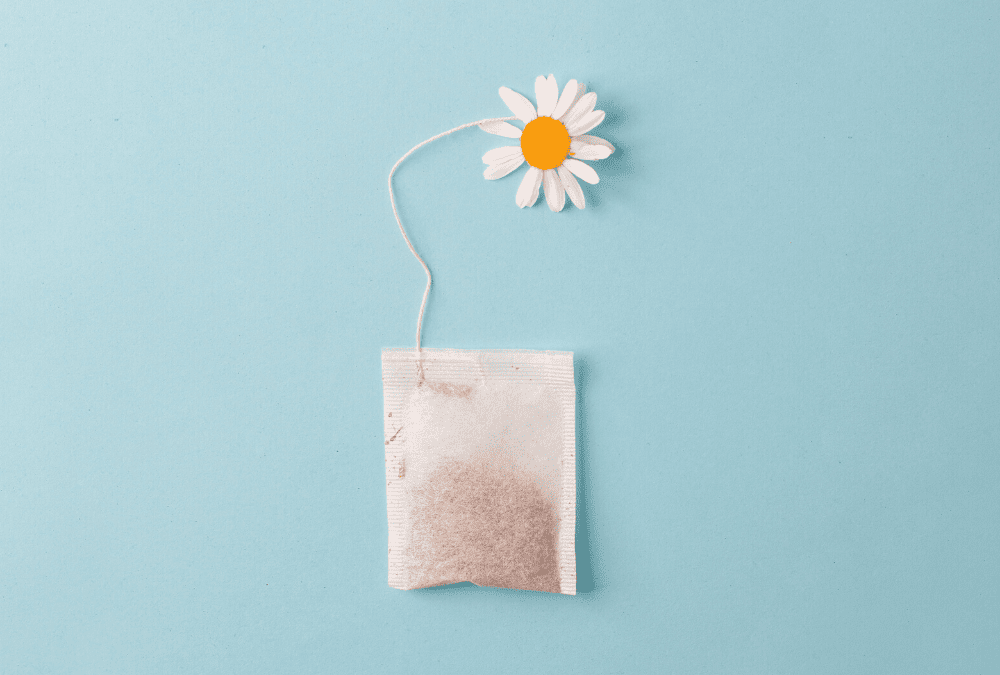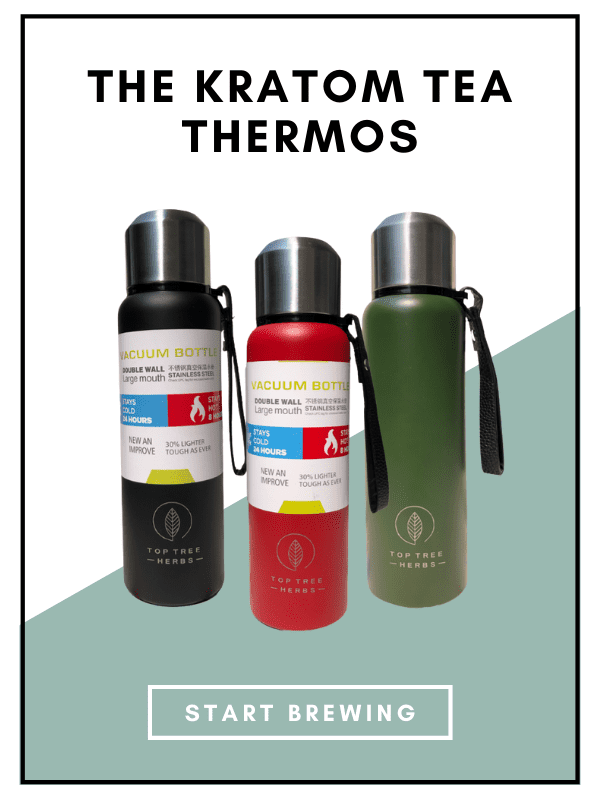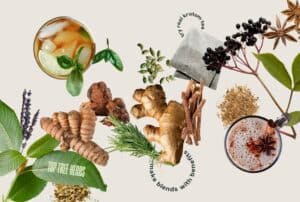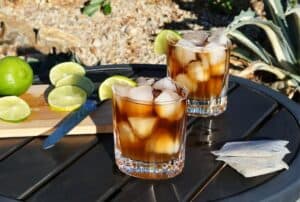Benefits of Herbal Tea
We’ve enjoyed herbal teas for millennia. We drink herbal tea for a number of reasons. Historically, drinking a boiled water tisane was one of the few ways to ensure that your beverage was safe to drink.
Today, with the rise of clean water infrastructure, hot teas are enjoyed for a different reason. Notably, they are consumed for the benefits of herbal tea, as well as their pleasing variety of flavors.
What’s the Difference Between “Herbal Tea” and “Tea”?
Herbal teas, or tisanes, are differentiated from “tea” by what plant is steeped in the hot water. When someone says tea, they are likely referring to a Camellia sinensis beverage.
The bush is native to China and it’s leaves produce the main six types of tea: green, black, oolong, white, pu-erh, and yellow.
These leaves contain caffeine in them, and grew in popularity throughout Europe, especially in England, in the 18th century. Before coming to the Western world, they were a staple of the Chinese diet.
Tea leaves were first consumed roughly 5000 years ago. C. sinensis was first consumed as a leafy green when first introduced to the diets of the ancient Chinese. They also dehydrated and swallowed it with water.
Yet before long, it evolved into the water infusion that we still enjoy today. In a similar time frame, also in China, but also in Egypt, herbal hot water infusions started to take off. These herbal teas imparted benefits aside from potable water and caffeine stimulation.
It is hard to say which herbal teas were the first to become popular, but history shows that almost every culture around the world had their own special tisane.
Popular Herbal Teas
Aside from C. sinensis, there are a wide variety of herbal teas vying for a spot in your tea cup. We’ve written about four exotic teas in the past, but there is no ignoring just how well known many of these herbal teas are. Arguably one of the most popular teas is Chamomile.
This delicate, white flower naturally grows throughout Europe and Africa, and has played an important part in the many cultures which have come and gone in those regions. It possesses a hypnotic aroma and drinking chamomile tea has shown to provide healthy slumber support.
Hailing from South Africa, Rooibos tea has been enjoyed for hundreds of years for its fruity and delicious flavor. Packed with vitamins, rooibos has gained popularity as a decaf tea option.
Blending function and flavor fantastically is ginger tea. Often reached for when your stomach begins to feel uneasy, ginger tea is a staple in many mothers’ medicine cabinets.
Ginger has been an invaluable part of the Traditional Chinese Medicine pharmacopoeia for millennia. It’s spicy flavor will warm up your mouth, and will delight the senses on a cold winter’s day.
These herbal teas are immensely popular, enjoy a long history of traditional use, and provide amazing wellness benefits. Yet to say that we’ve sifted through all the herbal tea options is a lie. Many previously unknown traditional teas are slowly making their way into the mainstream.
An Old, New Herbal Tea
In this post we’ll be focusing on a special and relatively unknown herbal tea. The benefits of this herbal tea are vast, and cover a wide range of, seemingly, contradicting effects. We are, of course, talking about kratom tea.
Kratom
Kratom is a leaf from a tree (Mitragyna speciosa) in the coffee family. It’s natural range is spread throughout the tropics of South East Asia. It begins at the base of the Himalayas and extends into the Nusantara islands. Thailand is at the center of the kratom habitat.
Similarly, kratom is at the center of Thai culture. The written history of kratom tea drinking in Thailand goes back to the middle of the 17th century.
However, many ethno-anthropologists believe that the use of kratom goes back thousands of years. The M. speciosa trees can grow taller than 80 feet in the wild, with trunks of three feet in diameter or more.
There are entire forests of kratom trees, although the habitat was greatly reduced in the 1940s due to Thai laws prohibiting its consumption.
In the 1970s the kratom population was attacked even further, resulting in there being one uninterrupted old growth kratom forest left in Thailand.
Thankfully Thailand has changed their tone regarding this traditional tea leaf. Legislative actions have been taken to strengthen the role of kratom in Thai culture and their economy.
Energizing Herbal Tea
For the majority of the history of kratom tea, it has primarily been enjoyed by physical laborers. Farmers and day laborers consume kratom in two ways. They either pluck the leaf off of a nearby tree and chew it, or they brew the leaves into a tea. Chewing on the leaves only takes a few seconds.
The leaf is taken in hand and the stem is removed to prevent any poking or small lacerations in the mouth. The destemmed leaf is then rolled into a small, tight quid and gently chewed. Expressing juices from the leaf and coating the mucus membrane of the mouth. After only a few seconds of chewing, they spit the leaf out whole.
Contrary to the very short amount of time necessary to chew on kratom leaves, brewing kratom tea the traditional way takes hours. Usually you serve the tea to a group. In fact, one of the benefits of kratom herbal tea is a slight social lubrication.
Handfuls of leaves are torn by hand and added to a pot of water. The cauldron is placed over a fire where it is left to simmer for two to three hours. For both kratom tea and chewed kratom leaves, the effects are similar.
Farmers employ kratom to feel energized. This allows them to work harder, longer, and be more productive all while enjoying themselves more than if they did not have the kratom. In many ways, the Thai working class’s use of kratom is very similar to it’s botanical cousin, coffee.’
Herbal Tea for Wellness
Another benefit of kratom herbal tea is it’s general wellness benefits. The energizing effects of kratom tea occur with the consumption of small amounts. When it comes to serving sizes that replicate the effects of coffee, less is more.
However, that doesn’t mean that there is no use consuming an extra serving. As the serving size increases, the energizing effects begin to fade and are replaced with a relaxing, wellness boost for the whole body.
All body types are different and will respond differently to the serving sizes, but the general trend is such. Roughly double the amount of kratom needed to be energizing will support destressing, and tripled can support healthy sleep.
Because of this unique and pleasant property of kratom tea, the benefits of it as an herbal tea are plentiful. The farmers that drink kratom every day are practicing . Yet folk traditions carefully describe when and how much kratom tea to consume for these other wellness purposes.
Modernization of the Traditional Practice
Today, kratom is rapidly becoming a global phenomenon. In the United States alone it is estimated that 10-15 million people consume some form of the leaf daily.
Interestingly, a majority of these consumers do so in a way that has no rooting in the traditional practice.
As a way to decrease international shipping costs, most kratom arrives on the shores of America as a dehydrated, micronized powder.
Largely ignorant of the millennia of traditional safe use, this majority will swallow the leaf powder whole. Swallowing kratom powder is undesirable for a multitude of reasons. For instance, swallowing the powder highlights and intensifies kratom’s unpalatable flavors.
To make an unpleasant taste even worse, the powder has a grittiness that invokes a feeling of chewing sand. On top of ruining the taste, kratom powder is quite dry and can dehydrate those who “toss and wash” the powder if they are not careful.
Clearly, swallowing kratom powder is undesirable. Yet fresh leaves are largely unavailable in the United States, and a three hour brewing process is inconvenient.
This was the problem we were faced with as we reckoned with desiring the benefits of kratom herbal tea, yet despised the act of swallowing the powder. We knew we wanted to return to the traditional kratom tea, but recognised that convenience and timeliness would be pivotal factors in it catching on.
Kratom Tea Bags and A Novel Brewing Technique
After some experimentation, we were able to crack the code and deliver the benefits of the herbal tea with unprecedented convenience. Top Tree Herbs kratom tea bags are filled with whole, crushed-leaf kratom.
Unlike kratom powder, crushed leaf kratom includes the stems just like in the traditional, whole leaf kratom brews that take three hours. However, we’ve managed to decrease the necessary brewing time to just 20 minutes.
To brew Top Tree Herbs kratom tea bags, you’ll need a thermos and a source of food safe acid. We prefer a citrus juice like lemon, but a tea bag rich in vitamin C will also suffice.
To develop this brewing method, we took a deep dive into the chemistry behind kratom alkaloids and solvency. The explanation is too long for this post. You can read a complete breakdown here.
Brewing your kratom tea is as simple as adding your teabags to your thermos and squeezing half a lemon or about a teaspoon of lemon juice from concentrate over them. While the acid and kratom meld, bring your water to a rolling boil.
The key to a strong and successful brew is maintaining a very hot temperature for the entire 20 minute steep time. You should cap your thermos as soon as you add the boiling water.
Simply pour your tea into a mug after you’ve finished steeping it and add any desired sweetener or flavoring. Let it cool and then enjoy! (As a bonus, you can repeat the brewing process with the same tea bags for a slightly weaker second brew.)
Taste
Kratom tea has a pleasantly earthy, bitter flavor to it. As when first consuming coffee, the flavor initially overwhelms your palate with a monolithic bitterness. Soon, however, you become accustomed to the taste and the bitterness recedes to reveal a melody of fragrances and flavors.
We love a classic plain kratom tea with nothing but the splash of lemon juice for flavor. But there are loads of great recipes for taking your brew to the next level. You can check out our dedicated kratom tea recipe book for more ideas, or you can purchase kratom herbal tea blend bags from our store for added flavor and functionality.






